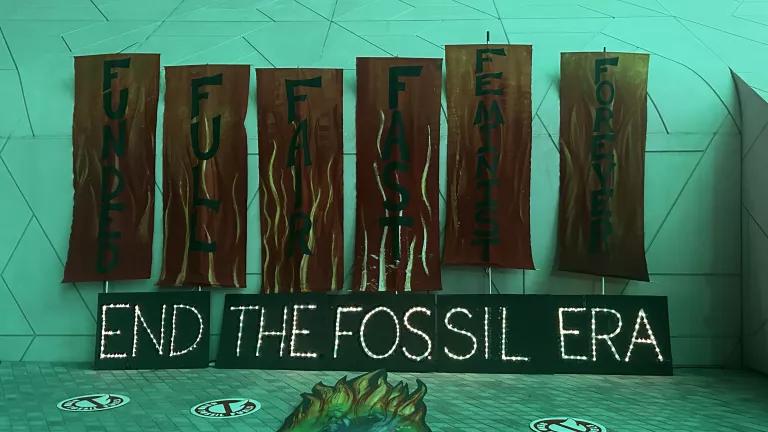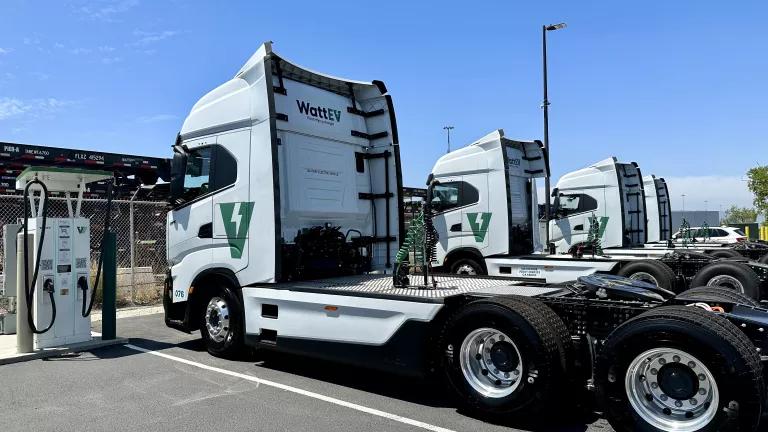
Part of NRDC's Year-End Series Reviewing 2015 Energy Developments
In signing the Paris Agreement, nations across the world are taking a much-needed step toward cutting carbon pollution from fossil fuel use and fortunately, the United States has a strong start--particularly in the traditionally oil-dependent transportation sector. Strong fuel efficiency and clean vehicle standards are proven pathways to cleaner air and lower fuel bills for drivers--and this year has seen advances in both.
Here's a summary of 2015 progress in cleaning up the dangerous emissions from our cars and trucks:
Heavy trucks: Standards proposed, and should be stronger
In June, the U.S. Environmental Protection Agency (EPA) and Department of Transportation proposed standards to cut fuel use and carbon pollution from tractor-trailers and other heavy highway trucks. The standards are an important opportunity to continue to reduce the pollution from trucks.
Improving the mileage efficiency of trucks is a necessary step to meeting our climate goals and, fittingly, a key part of President Obama's Climate Action Plan to slash emissions. Heavy trucks are big polluters because they guzzle diesel fuel. They burn about 20 percent of the fuel used in the entire transportation sector while comprising only about 4 percent of the vehicles on the road.
We can do better. For example, tractor-trailers--which consume about two-thirds of all trucking fuel--can advance from 6 mpg to over 10 mpg with cost-effective technologies and achieve at least a 40 percent reduction in fuel use and carbon pollution, as described in this fact sheet.
Therefore, NRDC is urging the government oversight agencies to adopt the strongest fuel efficiency standards possible--achieving maximum feasible emissions reductions--when they are finalized in 2016.
Cars: Fuel economy standards are working
Thanks to current automobile fuel economy and carbon pollution standards, Americans are saving money at the pump and new vehicles are at their cleanest levels ever. Current low gasoline prices are also contributing to lower fuel bills but we don't know how long prices will stay down. You can only be assured of lower bills if you use a more fuel-efficient vehicle (or transit, walking and biking) to buy less gasoline. Last week, EPA released data showing that clean car standards are driving reductions in carbon dioxide (CO2) emissions and improvements in efficiency.
Automakers have been improving fuel economy as a primary means of cutting carbon pollution. Over the last 10 years, new vehicles have improved by 5 miles per gallon (mpg), which is good for the environment and consumers. A jump of 5 mpg means fewer trips to the gas pump and, at $2.50 per gallon, more than $300 in annual fuel bill savings for a typical driver.

In 2016, the EPA, along with the National Highway Traffic Safety Administration and California Air Resources Board, will start an evaluation of the fuel economy and carbon pollution standards for model years 2022 through 2025. Based on an analysis by the National Research Council, automakers already appear poised to meet the 2025 standards using cost-effective, primarily conventional technologies, such as downsized turbocharged engines, 8-speed automatic transmissions, and lightweight materials. The study found that electrified powertrains were not needed to meet the standards for a mid-sized car. Still, we expect the market for electric vehicles to continue to expand to meet customer demand.
Electric vehicles: Growing adoption points way to a clean energy future
As of October, there were about 375,000 plug-in electric vehicles (EVs) on America's roads, according to EDTA sales figures. Meanwhile, the number of different EV models available has grown from two in 2010 to over 29 today. That is encouraging, and we'll need to continue to expand electric vehicle availability and adoption to meet our long-range climate targets.
Earlier this year, NRDC's joint research with the Electric Power Research Institute confirmed fueling transportation through electricity instead of oil could be a huge lever for reducing carbon pollution. The study found that by charging vehicles and off-road equipment with clean energy like wind and solar, we could reduce carbon pollution by 550 million metric tons annually in 2050--equivalent to the emissions from 100 million of today's passenger cars. At the same time, we would reduce other air pollutants, such as ozone and particulate matter that threaten our environment and health.
California is setting the stage for electric utilities to help advance charging infrastructure. Landmark climate legislation passed this year directs the electric industry to propose "programs and investments to accelerate widespread transportation electrification to reduce dependence on petroleum, meet air quality standards, achieve the goals set forth in the Charge Ahead California Initiative, and reduce emissions of greenhouse gases to 40 percent below 1990 levels by 2030 and to 80 percent below 1990 levels by 2050." In sum, California's utility industry is charged with a directive to electrify cars, trucks, and buses in a manner that supports the grid and ensures more people have access to a cleaner transportation fuel that's the cost-equivalent of dollar-a-gallon gas.
In 2016, keep an eye out for other states to follow California. Leaders from several Northeast region states supporting the ZEV program have announced joint efforts to focus on regional policies that will further cut transportation carbon pollution. This will undoubtedly include strengthening standards for car and truck efficiency and accelerating the use of electric vehicles.
And what does all this mean for the average driver? Lower fuel bills, fewer trips to the gas pump and cleaner air.
Photos above by the author.




